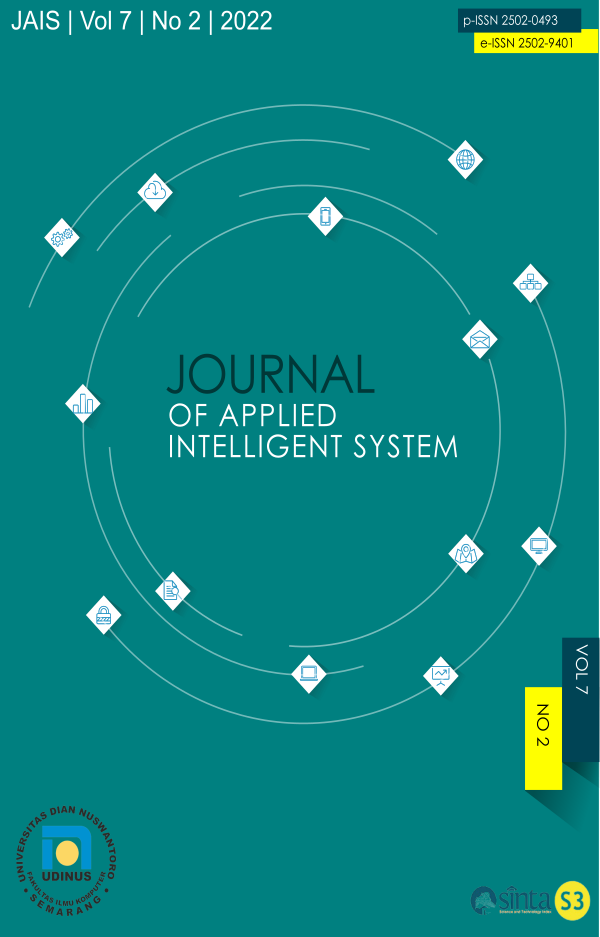Visitor Prediction Decision Support System at Dieng Tourism Objects Using the K-Nearest Neighbor Method
DOI:
https://doi.org/10.33633/jais.v7i2.6821Abstract
A tourist target is anything that attracts a visitor or tourist to come to visit a place or area. Tourism goods play an important role in a country or region, becoming a source of national foreign exchange, increasing human resources, and improving the economy of surrounding communities. The problem posed in this study is how to implement a decision support system in predicting visitor numbers for Dieng tourists using the k-nearest neighbor method. The purpose of this study is to help the local government and surrounding communities to improve facilities such as restaurants, places of worship, parking lots, clean toilets so that tourists can feel safe and comfortable when visiting Dieng. Helps manage tourism targets. is what you give. These attractions using a decision support system as a process to predict visitors. The number of visitors who visited in December 2017 was 421,394, which serves as a reference for predicting the number of visitors who will visit Dieng in the following year. The predicted result is 29569.25 visitors with a parameter value of k = 8 and a minimum RMSE value of k = 1/0.References
Ningsih, A. S., Waspiah, & Salsabilla, S. (2019). Indikasi Geografis atas Carica Dieng Sebagai Strategi Penguatan Ekonomi Daerah. Suara Hukum, 105-120.
Ningsih, E., Dedih, & Supriyadi. (2017). SISTEM PENDUKUNG KEPUTUSAN MENENTUKAN PELUANG USAHA MAKANAN YANG TEPAT MENGGUNAKAN WEIGHTED PRODUCT (WP) BERBASIS WEB. ILKOM Jurnal Ilmiah Volume 9 Nomor 3, 244-254.
Nugroho, C. G., Nugroho, D., and Fitriasih, S. H. DECISION SUPPORT SYSTEM FOR THE SELECTION OF CONTRACEPTION METHODS IN WOMEN OF RELIABLE AGE WITH K-NEAREST NEIGHBOUR (KKN) ALGORITHM. Jurnal Ilmiah SINUS. 2015; 21-29.
Mustakim, & Oktaviani, G. (2016). Algoritma K-Nearest Neighbor Classification Sebagai Sistem Prediksi Predikat Prestasi Mahasiswa. Jurnal Sains, Teknologi dan Industri, Vol. 13, No.2, 195-202.
Pelangi, H. R., Chandra, K., and Yuliyanti, L. APPLICATION OF DATA MINING TO DETERMINE THE POTENTIAL OF DAILY RAIN USING THE K NEAREST NEIGHBOR (KNN) ALGORITHM. LPPM STMIK Lombok. 2020; 3(1).
Setyoko, W., Hasbi, M., & Fitriasih, S. H. (2018). SISTEM PENDUKUNG KEPUTUSAN PREDIKSI POTENSI KUALITAS KREDIT CALON DEBITUR MENGGUNAKAN METODE K-NEAREST NEIGHBOR PADA BPR KARTASURA MAKMUR DI SUKOHARJO. Jurnal Tikomsin, 8.
Rusydiana, A. S. (2020). PREDIKSI PERTUMBUHAN PERBANKAN SYARIAH DI INDONESIA TAHUN 2020 DENGAN QUANTITATIVE METHODS. Jurnal Ekonomi Syariah, Vol. 4, No. 2., 75-91.
Cholifah, W. N., Yulianingsih, & Sagita, S. M. (2018). PENGUJIAN BLACK BOX TESTING PADA APLIKASI ACTION DAN STRATEGY BERBASIS ANDROID DENGAN TEKNOLOGI PHONEGAP. Jurnal String Vol. 3 No.2 Desember 2018, 206-210.
Munawar. (2018). Analisis Perancangan Sistem Berorientasi Objek dengan UML. Bandung: Informatika.
Riszky, A. R., & Sadikin, M. (2019). Data Mining Menggunakan Algoritma Apriori untuk Rekomendasi Produk bagi Pelanggan. Jurnal Teknologi dan Sistem Komputer, Volume 7, Nomor 3, 103-108.
Budiman, A. S., & Parandani, X. A. (2018). UJI AKURASI KLASIFIKASI DAN VALIDASI DATA PADA PENGGUNAAN METODE MEMBERSHIP FUNCTION DAN ALGORITMA C4.5 DALAM PENILAIAN PENERIMA BEASISWA. Jurnal SIMETRIS, Vol. 9 No. 1, 565-578.
Nugraha, P. D., Al Faraby, S., & Adiwijaya. (2018). Klasifikasi Dokumen Menggunakan Metode k-Nearest Neighbor dengan Information Gain. e-Proceeding of Engineering : Vol.5, No.1, 1541.
Downloads
Published
Issue
Section
License
- Authors retain copyright and grant the journal right of first publication with the work simultaneously licensed under a Creative Commons Attribution License that allows others to share the work with an acknowledgment of the work's authorship and initial publication in this journal.
- Authors are able to enter into separate, additional contractual arrangements for the non-exclusive distribution of the journal's published version of the work (e.g., post it to an institutional repository or publish it in a book), with an acknowledgment of its initial publication in this journal.
- Authors are permitted and encouraged to post their work online (e.g., in institutional repositories or on their website) prior to and during the submission process, as it can lead to productive exchanges, as well as earlier and greater citation of published work (See The Effect of Open Access).











